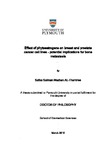Effect of phytoestrogens on breast and prostate cancer cell lines – potential implications for bone metastasis
| dc.contributor.supervisor | Fox, Simon W. | |
| dc.contributor.author | Al-thamiree, Safaa Salman Mezban | |
| dc.contributor.other | Faculty of Health | en_US |
| dc.date.accessioned | 2019-03-29T15:46:28Z | |
| dc.date.available | 2019-03-29T15:46:28Z | |
| dc.date.issued | 2019 | |
| dc.identifier | 10440867 | en_US |
| dc.identifier.uri | http://hdl.handle.net/10026.1/13585 | |
| dc.description.abstract |
The effect of phytoestrogens on breast and prostate cancer cell lines – potential implications for bone preferential metastasis to bone Safaa Salman Mezban AL-Thamiree Abstract Many epidemiological studies indicate that diets rich in phytoestrogens (PE), especially soy and grain products, may be associated with a lower risk of some steroid hormone-dependent cancers such as breast and prostate. In particular PE have been shown to reduce the incidence of skeletal metastasis which have a high degree of morbidity and mortality. However, the most effective combinations of PEs and the mechanism through which they may reduce bone metastasis remain unclear. Therefore, this study aims to establish the most effective combinations of common dietary PE on breast and prostate cancer line proliferation, motility, and expression of genes implicated in disease progression and preferential metastasis to the skeleton. The potential modifying effect of cytokines that tumour cells are exposed to in the bone micro environment will also be studied including TGF-β, BMP7 and IL-33. Results showed that phytoestrogens genistein and daidzein significantly reduced prostate cancer cell viability (PC3 cells) with concentration 10-7 M (15 %, P = 0.01) and 10-6 M (11%, P = 0.04) for genistein and for daidzein the decrease in cell number was (18%, P value = 0.04) for 10-8 M and (22 %, P = 0.01) for 10-7 M. In breast cancer cell line (MCF7) genistein and coumestrol showed a significant decrease in cell number while daidzein did not. The decrease in (MCF7) cell number with genistein was (15 %, P = 0.04) and (25 %, P = 0.04) for 10-6 M and 10-5 M respectively, while in coumestrol concentrations 10-7 , 10-6 and 10-5 M showed the most significant decrease in cell number and were (29 %, P = 0.03), (34 %, P= 0.01) and (37%, value = 0.007) respectively. Motility results showed no significant reduction in the closure time of the scratch in both cell lines and there was an acceleration in the healing time of the scratch in both cell lines but was significant only in breast cell line (MCF7) with coumestrol after 6 ,12 and 24 hours at concentrations between (10-9 - 10-5 M). Non-selective oestrogen receptor modulator (ICI 182,780) abolishes the effect of genistein (10-7 and 10-6 M) and daidzein (10-8 and 10-7 M) reduction in cell viability and increased PC3 cell numbers significantly. In MCF7 cells, (ICI 182,780) also abolished the effect of coumestrol and genistein and increased the cell numbers but not to a significant levels. While genistein, daidzein and coumestrol reduced breast and prostate cell viability individually in an oestrogen receptor dependent manner and this beneficial effect is lost when the effective concentrations are combined. Although, transforming growth factor β (TGFβ), shows antagonist effect on phytoestrogens induced changes when combined with (daidzein and genistein) and blocks any effect of PEs and increase collagen type I gene expression. In MCF7 cells, the non-inhibitory effect of individual genistein on PTHrP is lost in the presence of TGFβ but continues with significant decrease with snail. The non-inhibitory effect of coumestrol on PTHrP and snail genes expression altered to reduced significantly which suggest a strong effect of TGFβ on coumestrol and genistein action by interfering as a bone microenvironment cytokine. While bone morphogenic protein 7 (BMP7) had an inhibitory effect for the PEs (daidzein and genistein) and increased the expression of Runx2 in prostate cancer cell line. In MCF7 cells, BMP7 inhibits the effect of (genistein and coumestrol) and increased the expression of snail to a high level. Interleukin-33 (IL-33), reverse the inhibitory individual effect of phytoestrogens on Runx2, CXCR4, snail and Integrin α5 gene expression in prostate and breast cancer cell lines. In conclusion, phytoestrogens are effective when administrated individually but lose their effect in combination with other phytoestrogens. Clinicians must consider the overall profile of phytoestrogens before administration. Epidemiologically, what applied to an area regarding the effect of phytoestrogens must not apply to other areas. Hence, administrating phytoestrogens at early ages might be of beneficial effect than in elder ages. | en_US |
| dc.description.sponsorship | Iraqi ministry of higher education and scientific research | en_US |
| dc.language.iso | en | |
| dc.publisher | University of Plymouth | |
| dc.subject | Breast cancer | |
| dc.subject | Prostate cancer | |
| dc.subject | Phytoestrogens | en_US |
| dc.subject.classification | PhD | en_US |
| dc.title | Effect of phytoestrogens on breast and prostate cancer cell lines – potential implications for bone metastasis | en_US |
| dc.type | Thesis | |
| plymouth.version | publishable | en_US |
| dc.identifier.doi | http://dx.doi.org/10.24382/757 | |
| dc.rights.embargoperiod | No embargo | en_US |
| dc.type.qualification | Doctorate | en_US |
| rioxxterms.version | NA |
Files in this item
This item appears in the following Collection(s)
-
01 Research Theses Main Collection
Research Theses Main


